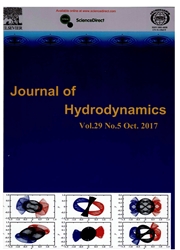

 中文摘要:
中文摘要:
在气-液界面Richtmyer-Meshkov(R-M)不稳定性研究的基础上,利用不同流体间密度的差异,构造了空气-硅油-水、空气-酒精-硅油两种流体粘度方向迥异的气-液-液三相界面,实验中以氮气作为高压驱动气体,在不同激波马赫数下对这两种界面R-M不稳定性后期尖钉与气泡区发展进行了测量与统计,通过对实验数据的分析,得出了相关规律,并用这些规律与已有的单层气-液界面R-M不稳定性研究成果作比较,得出了异同点。同时,还研究了两种三相界面在R-M不稳定发展中的差异。实验结果表明:当流体的粘度梯度方向(从小到大的方向)与激波方向一致时,界面失稳更加明显,湍流混合更为显著。
 英文摘要:
英文摘要:
This paper is based on our previous study of the Richtmyer-Meshkov(RM) instability research of a gas-liquid interface.Using the fluids with different densities,one can build two kinds of three-phase interfaces of gas-liquid-liquid,i.e.,gas-silicone oil-water and gas-alcohol-silicone oil interfaces,which have totally different direction of viscosity gradient.In the experiment,we use nitrogen gas as the high pressure driving gas and measure the development of spike height and bubble depth from these two interfaces at different shock wave Mach numbers.After analyzing all the experimental data we find some regular flow patterns.Then we compare the regular pattern with the results that we have already known.Meanwhile,the difference between the two kinds of three-phase interfaces in R-M instability development is also studied in this paper.The result shows that when the liquid viscosity gradient direction is agreed with the shock wave motion direction,the instability of the interface and the turbulent mixing become more significant.
 同期刊论文项目
同期刊论文项目
 同项目期刊论文
同项目期刊论文
 期刊信息
期刊信息
